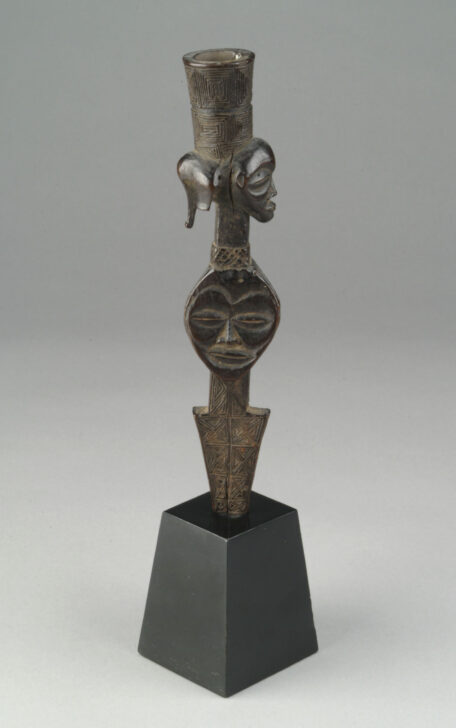Mortar
Chokwe

Description
Subject Matter:
Wooden mortars with anthropomorphic supports were carved by many peoples of central Africa, including the Bena Lulua, Chokwe, and Luba. Attributed to the Chokwe who lived throughout different autonomous chiefdoms in Angola, Zambia, and the Democratic Republic of the Congo, this mortar was used to grind tobacco, a plant introduced into the region in the seventeenth century. The wide dispersion of tobacco mortars in Central Africa attests to the extensive trade in tobacco. Some Chokwe tobacco mortars are found to be accompanied by pestles and removable lids which served the dual purpose of grinding and carrying snuff. In addition to being used for a utilitarian purpose, this mortar also served as a symbol of prestige for men of high status and courtly power which is evident in its finely carved geometric and anthropomorphic representations. Chokwe elites, including the ruler or mwanangana (literally, “lord of the land”), commissioned elaborate mortars and snuffboxes from a professional sculptor or songi (derived from kusonga, "to carve") in which snuff could be served to guests of honor or be presented as offerings on ceremonial occasions.
This mortar's upper head is a representation of the ancestral hunter-hero Chibinda Ilunga, a revered figure who is memorialized in numerous Chokwe objects. The lower head represents the idealized female, or mwana pwo (literally, “young woman”) who symbolizes the female ancestor and bringer of fertility. Like abundance of game, fecundity is dependent upon the ruler, who inherits the responsibility of ensuring the community's prosperity and well-being. Paired together, Chibinda as the male paragon par excellence and the mwana pwo as the idealized female, represent ancestors – male and female – from whom the ruler solicits favors of benevolence; the inclusion of these two symbolic heads therefore also serves as a potent visual reminder of the ruler's immense duties and obligations.
References:
African Form and Imagery: Detroit Collects. Ed. Judith A. Ruskin. Detroit: Detroit Institute of Arts Founders Society, 1996.
Bastin, Marie-Louise. La Sculpture Tshokwe. Alain et Francoise Chaffin: Meudon, 1982.
Jordan, Manuel. Chokwe! Art and Initiation Among Chokwe and Related Peoples. Prestel-Verlag: Munich, 1998.
Maurer, Evan M. and Niangi Batulukisi. Spirits Embodied: Art of the Congo, Selections from the Helmut F. Stern Collection. Minneapolis: The Minneapolis Institute of Arts, 1999.
Physical Description:
This wooden mortar is decorated by finely carved geometric patterns and features two anthropomorphic heads bearing recognizable Chokwe characteristics including coffeebean-shaped eyes enclosed in large ocular cavities. The lower head, the face of an idealized female (mwana pwo), forms the body of the mortar. The upper head, turned at a 90 degree angle from the lower head, is wearing a headdress which extends behind his face. Resting on top of the upper head is the bowl of the mortar.
Usage Rights:
If you are interested in using an image for a publication, please visit https://umma.umich.edu/request-image/ for more information and to fill out the online Image Rights and Reproductions Request Form.